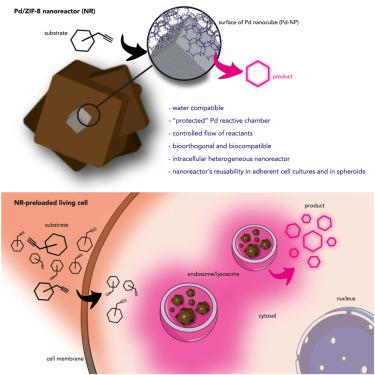Cell Reports Physical Science ( IF 7.9 ) Pub Date : 2020-06-17 , DOI: 10.1016/j.xcrp.2020.100076 Raquel Martínez 1 , Carolina Carrillo-Carrión 1 , Paolo Destito 2 , Aitor Alvarez 1 , María Tomás-Gamasa 2 , Beatriz Pelaz 3 , Fernando Lopez 2, 4 , José L Mascareñas 2 , Pablo Del Pino 1

|
Translating the potential of transition metal catalysis to biological and living environments promises to have a profound impact in chemical biology and biomedicine. A major challenge in the field is the creation of metal-based catalysts that remain active over time. Here, we demonstrate that embedding a reactive metallic core within a microporous metal-organic framework-based cloak preserves the catalytic site from passivation and deactivation, while allowing a suitable diffusion of the reactants. Specifically, we report the fabrication of nanoreactors composed of a palladium nanocube core and a nanometric imidazolate framework, which behave as robust, long-lasting nanoreactors capable of removing propargylic groups from phenol-derived pro-fluorophores in biological milieu and inside living cells. These heterogeneous catalysts can be reused within the same cells, promoting the chemical transformation of recurrent batches of reactants. We also report the assembly of tissue-like 3D spheroids containing the nanoreactors and demonstrate that they can perform the reactions in a repeated manner.
中文翻译:

核壳钯/MOF 平台作为活细胞和组织模型中的扩散控制纳米反应器。
将过渡金属催化的潜力转化为生物和生活环境有望对化学生物学和生物医学产生深远的影响。该领域的一个主要挑战是创造随时间保持活性的金属基催化剂。在这里,我们证明在基于微孔金属有机框架的斗篷中嵌入反应性金属核可以保护催化位点免受钝化和失活,同时允许反应物适当扩散。具体而言,我们报告了由钯纳米立方体核心和纳米咪唑酯框架组成的纳米反应器的制造,这些纳米反应器表现得像坚固、持久的纳米反应器,能够从生物环境和活细胞内的苯酚衍生的前荧光团中去除炔丙基基团。这些多相催化剂可以在同一电池内重复使用,促进反应物循环批次的化学转化。我们还报告了包含纳米反应器的组织状 3D 球体的组装,并证明它们可以以重复的方式进行反应。











































 京公网安备 11010802027423号
京公网安备 11010802027423号